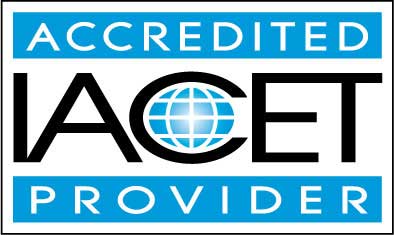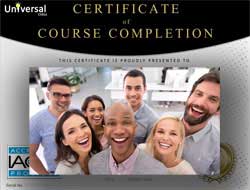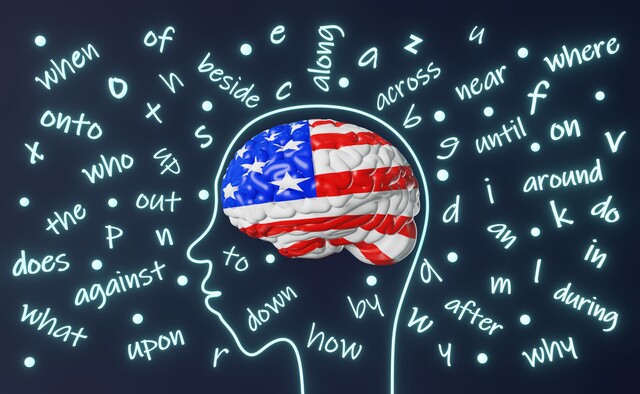Online Class: GED Test Preparation

no certificate
with CEU Certificate*
-
49Lessons
-
94Exams &
Assignments -
4,767Students
have taken this course -
37Hours
average time -
3.7CEUs
Course Description
Master the GED: Your Gateway to a Brighter Future
In the dynamic landscape of modern education, the GED (General Educational Development) test serves as a pivotal milestone for many. Whether you're aiming to accelerate your academic journey or unlock new vocational avenues, obtaining your GED can be transformative. Our meticulously designed online course serves as the ultimate compass to guide you through this essential rite of passage.
Why Our Course Stands Out:
-
Comprehensive Insights: Dive deep into the architecture of the GED test. We demystify the format, illuminating the core areas and content ensuring you're well-prepared for every twist and turn.
-
Resource-Rich Learning: From astute test-taking strategies to enlightening exercises and assignments, our course is brimming with tools to propel your GED preparation to stellar heights. Supplement your learning with our curated netlinks, offering deep-dives into critical topics -- all at your own pace.
-
Holistic Coverage: The GED is a vast ocean of knowledge, segmented into four crucial streams: Reasoning through Language Arts, Social Studies, Science Studies, and Mathematical Reasoning. While you won't be expected to know every ripple and wave, understanding the major currents is paramount. Our course, acting as your navigator, provides concise summaries and an abundance of practice resources for each pivotal topic.
In a world where knowledge truly is power, our GED prep course stands as a beacon for those eager to harness their potential. Whether you're reigniting past aspirations or embarking on a fresh academic endeavor, this course is tailored to ensure you walk into the GED test center with confidence and walk out with triumph.
Embrace this opportunity, enroll with us, and let's chart a course to a brighter, more promising future. Your success story starts here!
- Completely Online
- Self-Paced
- 6 Months to Complete
- 24/7 Availability
- Start Anytime
- PC & Mac Compatible
- Android & iOS Friendly
- Accredited CEUs

Course Lessons
Lesson 1. Navigating the GED: A Journey to Empowerment
Designed to open new educational and career doors, the GED test emphasizes practical knowledge application over rote memorization, with varied question types from multiple choice to extended responses that evaluate deep understanding. Upon completing the approximately seven-hour computerized test, candidates receive same-day feedback, fostering immediate growth and learning.Lesson 2. Navigating the Language Arts: Mastering the RLA Test for GED Success
This lesson outlines the RLA test as a vital step in acquiring a GED, emphasizing the importance of mastering English grammar, sentence construction, and comprehension skills. A score of 165 or higher indicates college readiness, which can lead to expanding educational pursuits.Lesson 3. Effective Sentence Construction
Mastering sentence structure, from differentiating complete sentences and fragments to correcting run-on sentences and comma splices, is essential for clear communication. Utilizing conjunctions and choosing between active and passive voices strengthens your writing, making it more direct and engaging.Lesson 4. Precision and Clarity in Written English
This guide emphasizes the importance of capitalization and punctuation as fundamental tools for crafting coherent and engaging sentences. By exploring usage through illustrative scenarios, learners gain valuable insights into writing with professionalism and expressiveness.Lesson 5. Navigating the Rivers of Thought: The Role of Structure in Writing
Effective paragraph structure balances clarity with conciseness, using topic sentences to anchor ideas and transitions to signal shifts, ensuring narratives remain intact and focused. From concise paragraphs that drive points home to the integration of varied details, structuring becomes an art form to preserve interest and avoid narrative choppiness.Lesson 6. Mastering Reading: Key Strategies Unlocked
Delve into the art of reading comprehension by understanding pivotal elements like main ideas and supporting details, akin to finding the heartbeat of a passage. Through strategic tools and skills, this exploration equips readers for mastery in navigating complex texts with confidence.Lesson 7. Fiction Decoded: Understanding Imaginative Narratives
Writing fiction is a creative art akin to painting or sculpting, using characters, settings, and plots to craft narratives that reshape readers' perceptions and emotions. Through characters and settings that resonate deeply, fiction connects diverse audiences to universal themes, from societal commentary to personal journeys.Lesson 8. Nonfiction Unraveled: A Journey of Knowledge and Enlightenment
Personal narratives such as biographies and autobiographies offer insight into individual lives, merging historical context and personal reflection. Through firsthand accounts, they educate and inspire, highlighting resilience against adversity and offering readers a deeper connection to the subject.Lesson 9. Beyond Essays: Mastering Extended Writing for the GED
A strong essay framework involves structured planning, writing, and revising, forming a blueprint for clear and impactful writing. Planning involves comprehending instructions; writing emphasizes narrative crafting with supporting evidence; and revising focuses on coherence and grammatical accuracy.Lesson 10. From Numbers to Success: Navigating the GED Math Test
Designed to evaluate more than just arithmetic skills, the GED Mathematical Reasoning Test challenges you to employ logical strategies in solving real-world problems. Achieving a passing score not only exemplifies mathematical competence but also resilience and adaptability, essential traits for academic and professional growth.Lesson 11. The Language of Whole Numbers: Addition, Subtraction, Multiplication, and Division
Mastering whole number operations like addition, subtraction, multiplication, and division is foundational for mathematical fluency and real-world application. These operations are essential tools that, once mastered, unlock the ability to solve complex mathematical challenges and understand symmetrical beauty in numbers.Lesson 12. Exploring the Mysteries of Numbers, Powers, and Roots
The lesson visualizes squared numbers to simplify abstract concepts, illustrating perfect squares with relatable examples. Familiarizing with techniques like estimating square roots or using calculators ensures adaptability when facing non-perfect square roots.Lesson 13. Decisions with Decimals
Understanding the place value of decimals allows us to read, compare, and manipulate them accurately, treating each digit's position as a component of a rhythmic base ten system. Whether aligning a list of numbers or determining which fraction is greater, this understanding transforms seemingly complex tasks into straightforward processes.Lesson 14. Percent Mastery
Calculating interest involves applying percents to money growth over time, with simple and compound interest as key concepts. By understanding these calculations, one can decipher loans, credit savings, and investment opportunities more effectively.Lesson 15. The Infinite Stretch of Real Numbers and Their Significance
Real numbers extend our comprehension beyond simply positive figures to include zero and negative quantities, influencing mathematical concepts, operations, and real-world applications. Understanding signed numbers on a number line and their absolute values aids in navigating mathematical operations like addition, subtraction, multiplication, and division, mirroring life's financial and temperature shifts.Lesson 16. Decoding the Math of Everyday Decisions: Ratios, Rates, Proportions
Ratios serve as fundamental comparisons between numbers, essential for analyzing situations in daily life, such as determining ratios at zoos or grocery stores. Simplifying these ratios offers clearer insights, helping individuals and businesses make strategic decisions and understand the composition of groups.Lesson 17. A Deeper Dive into Probability: Mastering Uncertainty
As a study of random events and outcomes, probability enhances our capacity to make informed decisions in daily life and across diverse fields, including business and medicine. Understanding its principles equips us with tools to better predict events, evaluate risks, and embrace complexity with confidence.Lesson 18. Data Decoded
Measures of central tendency such as mean, median, and mode offer unique perspectives on data, supporting effective analysis and decision-making. These measures help in contexts ranging from educational assessments to business inventory management.Lesson 19. Simplifying Expressions and Tackling Algebraic Challenges
Word problems integrate algebra with everyday challenges, requiring systematic approaches to unlock their mathematical constructs. By translating real-world scenarios into algebraic equations, learners can devise solutions to diverse problems from finance to logistics.Lesson 20. Balance in Mathematics: The Art of Equalities
Algebraic operations unlock a universe of possibilities by merging constants and variables to solve equations. This lesson explores addition, subtraction, multiplication, and division in algebra, emphasizing the importance of order of operations and substitution.Lesson 21. Linear Equations and Inequalities
This lesson will introduce you to linear equations and inequalities, including their properties, graphs, and solutions.Lesson 22. Systems of Linear Equations and Linear Inequalities
This lesson will teach you how to solve so-called systems of linear equations using substitution and will extend your understanding beyond simple equations in two dimensions to equations in many dimensions.Lesson 23. Functions
Once you have mastered the basic concepts associated with functions, you will then have all the tools you need to get into the more complicated (and more fun) aspects of algebra.Lesson 24. Geometry
Lesson topics include geometry vocabulary as well as measurements, angles and triangles relationships.Lesson 25. THE SOCIAL STUDIES TEST
This lesson will go over information and question formatting that will be on this section of the GED exam.Lesson 26. Civics and Government, pt. 1
Lesson material will include topics involving types of political systems, The United States Federal Government, the system of checks and balances, and the process of amending the Constitution.Lesson 27. Civics and Government, pt. 2
Just as the United States has a federal, or national, government, each state has their own government as well.Lesson 28. Economics, pt. 1
Lesson material will include topics involving the factors of production, economics and governments, supply and demand, imports and exports, and inflation.Lesson 29. Economics, pt. 2
Lesson material will include topics on the factors involved in economic growth, money and monetary policy, government and fiscal policy, and the American consumer.Lesson 30. Geography
Lesson material will include topics involving mapping, latitude and longitude, time zones, topography, climate, and population distribution.Lesson 31. World History, pt. 1
Lesson material will review topics of early humanity and civilizations.Lesson 32. World History, pt. 2
Lesson material will include topics involving the Middle Ages, the Renaissance, The Reformation and The Age of EnlightenmentLesson 33. World History, pt. 3
Lesson material will include topics involving the French Revolution, Central America, Eastern Europe, the Industrial Revolution, and World War 1.Lesson 34. World History, pt. 4
Lesson material will include topics involving the Russian Revolution and the rise of Communism, relationships between India and Pakistan , and the impact of technology on the world.Lesson 35. U.S. History, pt. 1
Lesson material will include topics involving the beginning of the formation of the United States, the formation of the American government, and the development of the Declaration of Independence.Lesson 36. U.S. History, pt. 2
Lesson material will include topics involving the beginning of U.S. domestic and foreign policy, the War of 1812, the Civil War, and the impact of the Industrial Revolution in the U.S.Lesson 37. U. S. History, pt. 3
Lesson material will include topics involving the United States as a world power, U.S. role in World War 1, the Suffrage Movement, the Roaring Twenties, the Stock Market Crash, and the New Deal.Lesson 38. U.S. History, pt. 4
Lesson material will include topics involving the United States in World War II, The Korean Conflict, and the Eisenhower presidency.Lesson 39. U.S. History, pt. 5
Lesson material will include topics involving the Kennedy Presidency, the Vietnam War, the Watergate Scandal, and the end of the Twentieth Century.Lesson 40. THE SCIENCE TEST
This lesson will go over information and formatting details of the Science Test for the GED.Lesson 41. Life Science: Biology pt. 1
This lesson will discuss topics including: the cell, structure of the Eukaryotic animal cell, structure Of the Eukaryotic plant cell, functions of a typical cell, diffusion, active transport, protein synthesis of cells, types of reproduction, genetics, anLesson 42. Life Science: Biology pt. 2
Several hundred years ago, as science began to advance, scholars needed a well organized system to talk about the vast number of organisms on the planet.Lesson 43. Chemistry, pt. 1
Just as the cell is the basic building block of life, the atom is the basic unit of matter. There are just over 100 types of atoms in the known universe, and these tiny particles combine to make all matter.Lesson 44. Chemistry, pt. 2
When elements combine in a chemical reaction, a new compound is formed that has properties different from the original components.Lesson 45. Physics, pt. 1
Physics is at work in your life every day. Its what keeps you from floating out into space and what keeps your car moving forward as you roll downhill.More Class Lessons...
Learning Outcomes
- Define the different question types used in the GED test by providing examples and identifying their unique characteristics in a practical assessment.
- Demonstrate the real-world application of skills acquired through GED preparation by solving a given problem related to budgeting or data analysis in a simulated context.
- Apply knowledge of Standard English grammar concepts, including sentence structure and punctuation, to construct coherent and concise written responses.
- Demonstrate the ability to analyze and interpret various types of reading passages by identifying themes, character motivations, and the author's intent.
- Demonstrate the ability to construct complete sentences by incorporating appropriate subjects and verbs to convey clear and complete thoughts
- Recognize and correct instances of run-on sentences and comma splices using appropriate punctuation, conjunctions, or sentence separation techniques
- Apply the appropriate punctuation, including commas and apostrophes, in sample sentences to demonstrate correct sentence structure and grammar usage while explaining the function of each punctuation mark.
- Define the primary rules of capitalization by listing common categories, such as proper nouns, titles, and geographical locations, and provide examples for each.
- Analyze paragraph coherence by evaluating and rearranging sentences to maintain a unified and logical progression of ideas.#
- Define the role of transitional words in writing by identifying and applying them to enhance flow and readability in written narratives.
- Analyze supporting details such as facts, statistics, and examples within a given text to evaluate their relevance and effectiveness in substantiating the main idea.
- Identify the main idea of a passage and articulate it in your own words, demonstrating an 80% comprehension level through a written summary.
- Identify the role of setting in fiction by analyzing how time, place, and mood create an engaging narrative experience.
- Demonstrate mastery of lesson content at levels of 70% or higher.
Additional Course Information

- Document Your Lifelong Learning Achievements
- Earn an Official Certificate Documenting Course Hours and CEUs
- Verify Your Certificate with a Unique Serial Number Online
- View and Share Your Certificate Online or Download/Print as PDF
- Display Your Certificate on Your Resume and Promote Your Achievements Using Social Media

Choose Your Subscription Plan
No Certificate / No CEUs
This course only
| Includes certificate | X |
| Includes CEUs | X |
| Self-paced |

|
| Instructor support |

|
| Time to complete | 6 months |
| No. of courses | 1 course |
Certificate & CEUs
This course only
| Includes certificate |

|
| Includes CEUs |

|
| Self-paced |

|
| Instructor support |

|
| Time to complete | 6 months |
| No. of courses | 1 course |
Certificates & CEUs
Includes all 600+ courses
| Includes certificate |

|
| Includes CEUs |

|
| Self-paced |

|
| Instructor support |

|
| Time to complete | 12 Months |
| No. of courses | 600+ |
Certificates & CEUs
Includes all 600+ courses
| Includes certificate |

|
| Includes CEUs |

|
| Self-paced |

|
| Instructor support |

|
| Time to complete | 24 Months |
| No. of courses | 600+ |
Related Courses
-
 33 hours
3.3 CEUs
World War l and ll
+ More Info
33 hours
3.3 CEUs
World War l and ll
+ More Info
-
 21 hours
2.1 CEUs
American Wars: American Revolution and Civil War
+ More Info
21 hours
2.1 CEUs
American Wars: American Revolution and Civil War
+ More Info
-
 72 hours
7.2 CEUs
Writing Help Course Bundle
+ More Info
72 hours
7.2 CEUs
Writing Help Course Bundle
+ More Info
-
 7 hours
0.7 CEUs
Introduction to Logic
+ More Info
7 hours
0.7 CEUs
Introduction to Logic
+ More Info
-
 14 hours
1.4 CEUs
Biology 360: From Molecules to Ecosystems
+ More Info
14 hours
1.4 CEUs
Biology 360: From Molecules to Ecosystems
+ More Info
-
 12 hours
1.2 CEUs
Business Math 101
+ More Info
12 hours
1.2 CEUs
Business Math 101
+ More Info
-
 8 hours
0.8 CEUs
Teaching Grammar to ESL Students
+ More Info
8 hours
0.8 CEUs
Teaching Grammar to ESL Students
+ More Info
-
 17 hours
1.7 CEUs
Basic Math 101
+ More Info
17 hours
1.7 CEUs
Basic Math 101
+ More Info






